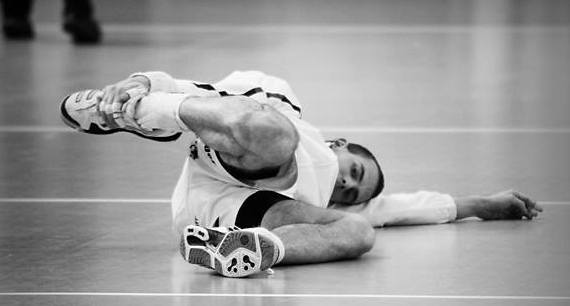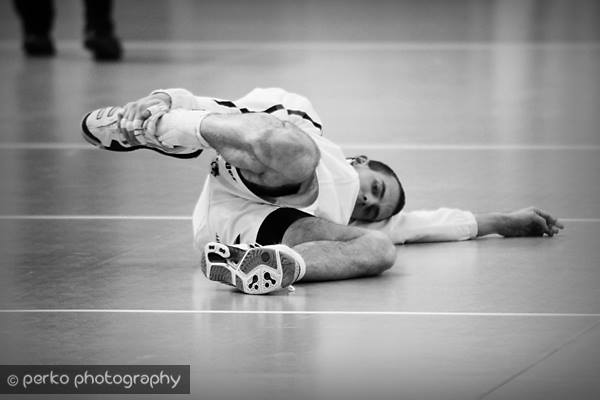From life.gaiam.com:
Nearly everyone has experienced knee pain. Whether it’s caused by arthritis, excessive foot pronation or overuse of the muscles that protect this vulnerable joint, our knees take a knocking. In fact, knee arthritis is the single greatest cause of chronic disability among U.S. adults age 65 and older.
Here’s the good news: Most chronic knee pain is avoidable. New research published in the New England Journal of Medicine suggests that exercise and physical therapy are just as effective as surgery for relief from chronic knee pain related to arthritis. Learning to strengthen and stretch key muscles that support the knees, and other ways to protect and take care of our knees, can ultimately prolong the health of this vital body part.
To relieve and prevent knee pain and its causes, try these recommendations from physical therapist Chantal Donnelly, a faculty member for the Doctor of Physical Therapy program at Mount Saint Mary’s College, a certified Pilates instructor in L.A., and author of the Strong Knees therapeutic exercise DVD from Gaiam.
1. Strengthen your butt
We know from research that knee injuries, including common Anterior Cruciate Ligament (ACL) tears, can occur when large hip muscles are weak. ACL tears, which are eight times more likely in women athletes, have been shown to lead to other cartilage tears and to correlate with knee arthritis later in life.
As a society, our butt muscles are weak. When the main butt muscle (gluteus maximus) is weak, it causes the pelvis to drop and the upper thigh bone (femur) to fall inward. This imbalance creates painful downward stress on the hip, knee and ankle every time you take a step.
Hip extensions are helpful exercises to strengthen the glutes. Learn why and how to properly do hip extensions in both standing and prone position in this clip from the Strong Knees DVD.
2. Stretch the muscles that support your knees
When butt muscles atrophy or become imbalanced because we tend to sit much of the day, the hamstrings and hip adductors (inner thigh muscles) also overwork — to compensate for the underdeveloped gluteus maximus — resulting in compressive force on the knee joint. By stretching out these support muscles, you decrease the chance that they’ll get tight and cause muscle imbalances. So remember the complementary two-fold process: As you strengthen naturally weak muscles like the glutes, also stretch supporting muscles like the inner thigh muscles.
My Strong Knees DVD shows how to do hamstring and hip adductor stretches in both the “7 Minutes to Save Your Knees” segment and the “Stretching” segment.
3. Tone your core muscles
Abdominal weakness will cause your pelvis to tilt forward, creating excessive low-back curvature and shifting the leg bones inward. You can experiment with this yourself: Over-arch your back and notice how your legs and knees want to roll in toward the midline of the body. Then flatten your back and notice how the opposite movement occurs at the legs.
Strengthening the core helps to keep your back in a neutral spine position and places the lower extremities — specifically the knees — in the best possible position for movement without joint compression.
There are so many ways to strengthen your abdominal muscles besides doing crunches. …
In addition to the core exercises on my Strong Knees DVD, consider Pilates workouts; Pilates was created with a strong emphasis on improving core strength to improve the function of the entire body. Or try fun core workout options like abs ball exercises, an abs routine on a fitness ball, or a core workout with elements of dance, yoga or kickboxing.
4. Maintain a healthy weight
Being overweight makes men five times more likely (and women four times more likely) to develop knee osteoarthritis. New research shows that a 10% decrease in weight will result in a 28% increase in knee function (such as for climbing stairs and walking). Another study found that for every 11 pounds a woman loses, there is a remarkable 50 percent decrease in the risk of knee arthritis.
Why? Fat decreases muscle strength, and excess body weight adds strain to knee joints. In fact, there’s an inverse relationship between body weight and quadriceps muscle strength: the higher your body weight, the weaker your knee muscles.
To start burning those extra calories required for weight loss without adding additional impact to the knees, try water aerobics, an elliptical trainer or cycling (making sure you have proper seat height).
5. Mind your feet
You may look great in three-inch stilettos, but keep in mind that high-heeled shoes increase the compressive force on your knee joints by 23%. Wearing heels also encourages tight calf muscles, another common cause of knee pain. A tight calf can pull the foot inward to a position called pronation, which essentially collapses the arch of the foot and causes the lower leg to roll inward, placing stress on the ankle and knee.
So embrace the flat shoe fashion trend and stretch out those calves. On the flip side, replace your workout sneakers frequently — every 300 miles, which could be three months or a year depending on your level of activity. This is a safe way to avoid wearing a shoe with poor cushioning support for your arches and joints.



One Comment
Leave a Reply